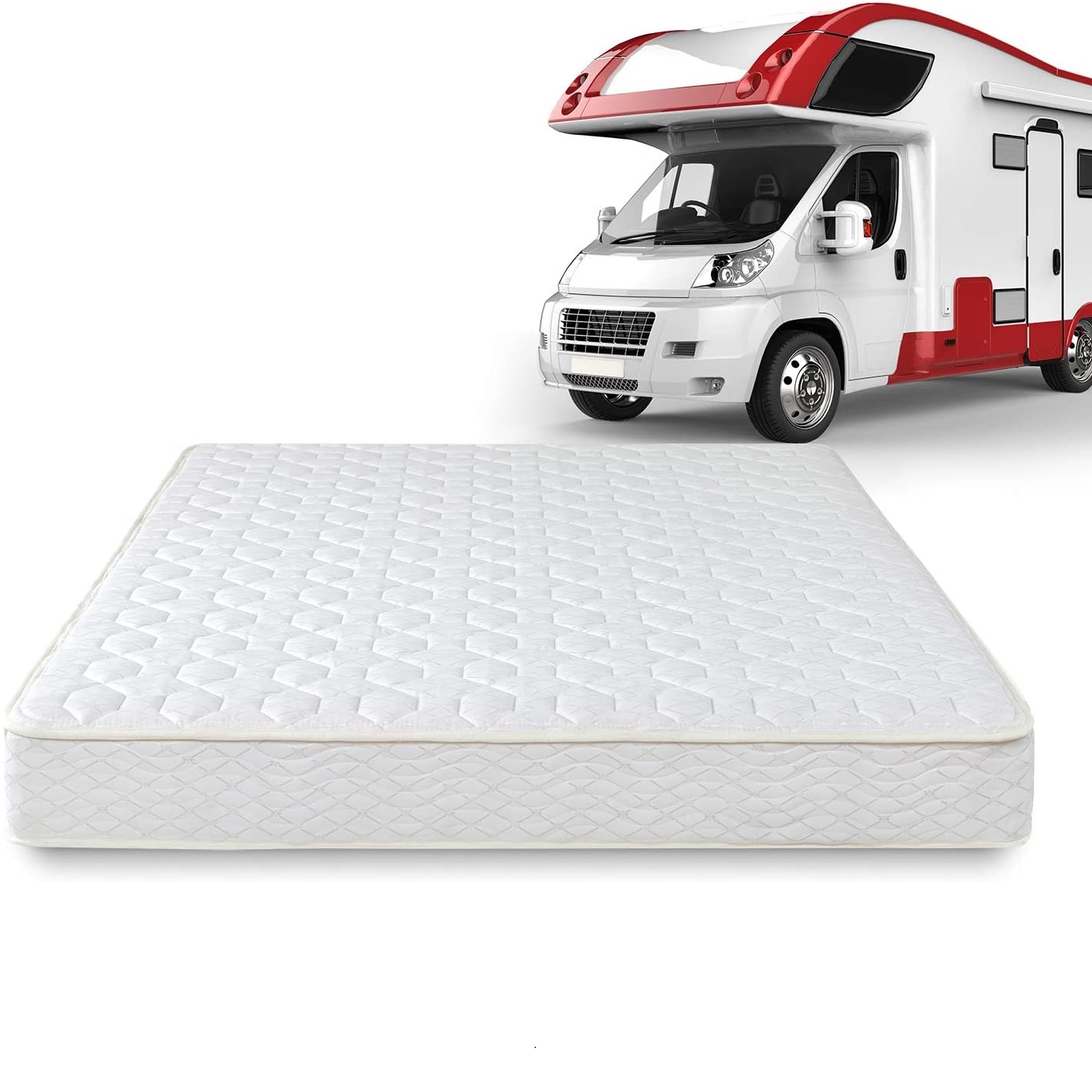
- Size Short Queen
- Brand Zinus
- Item Thickness 8 Inches
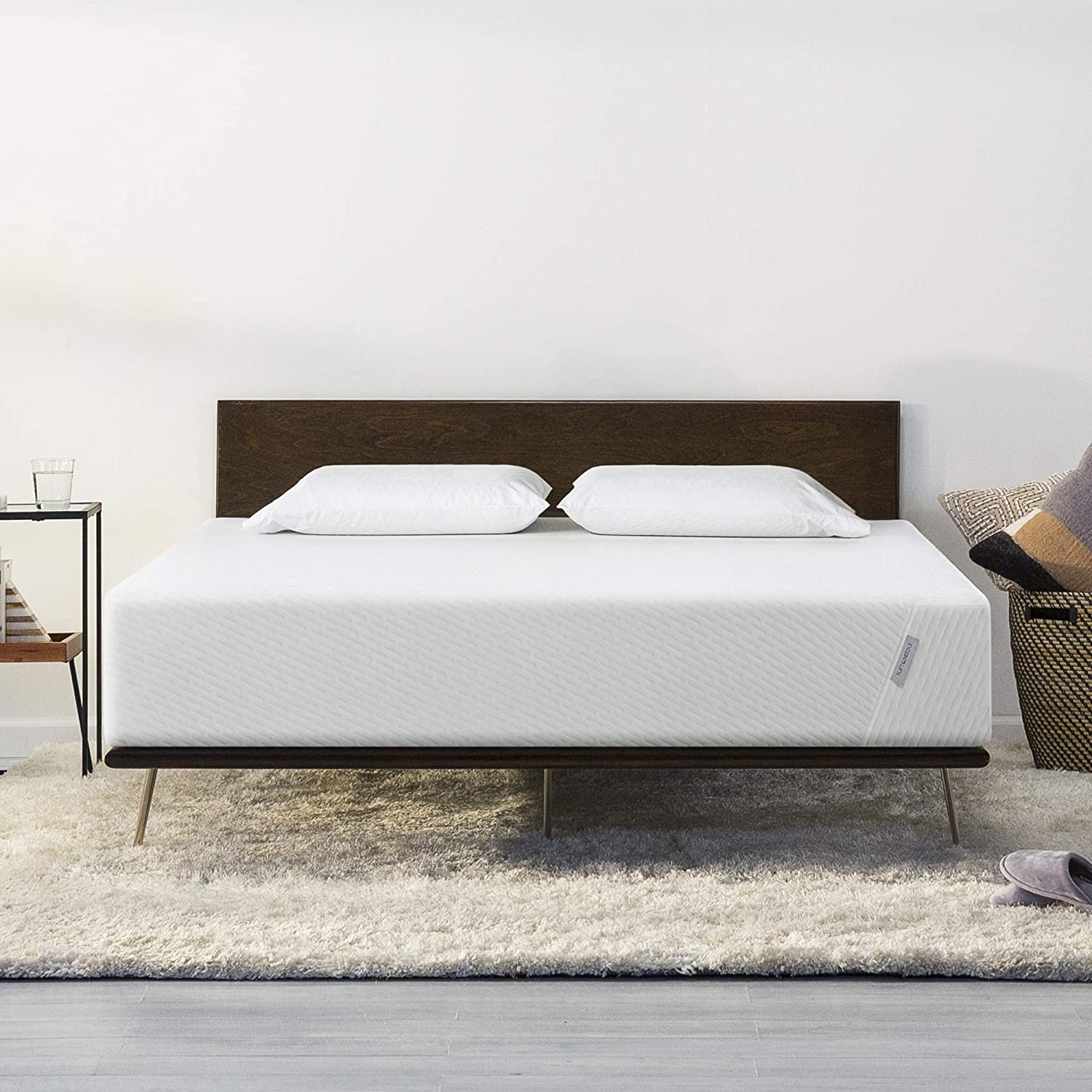
- Size Queen
- Brand Tuft & Needle
- Item Weight 72 Pounds
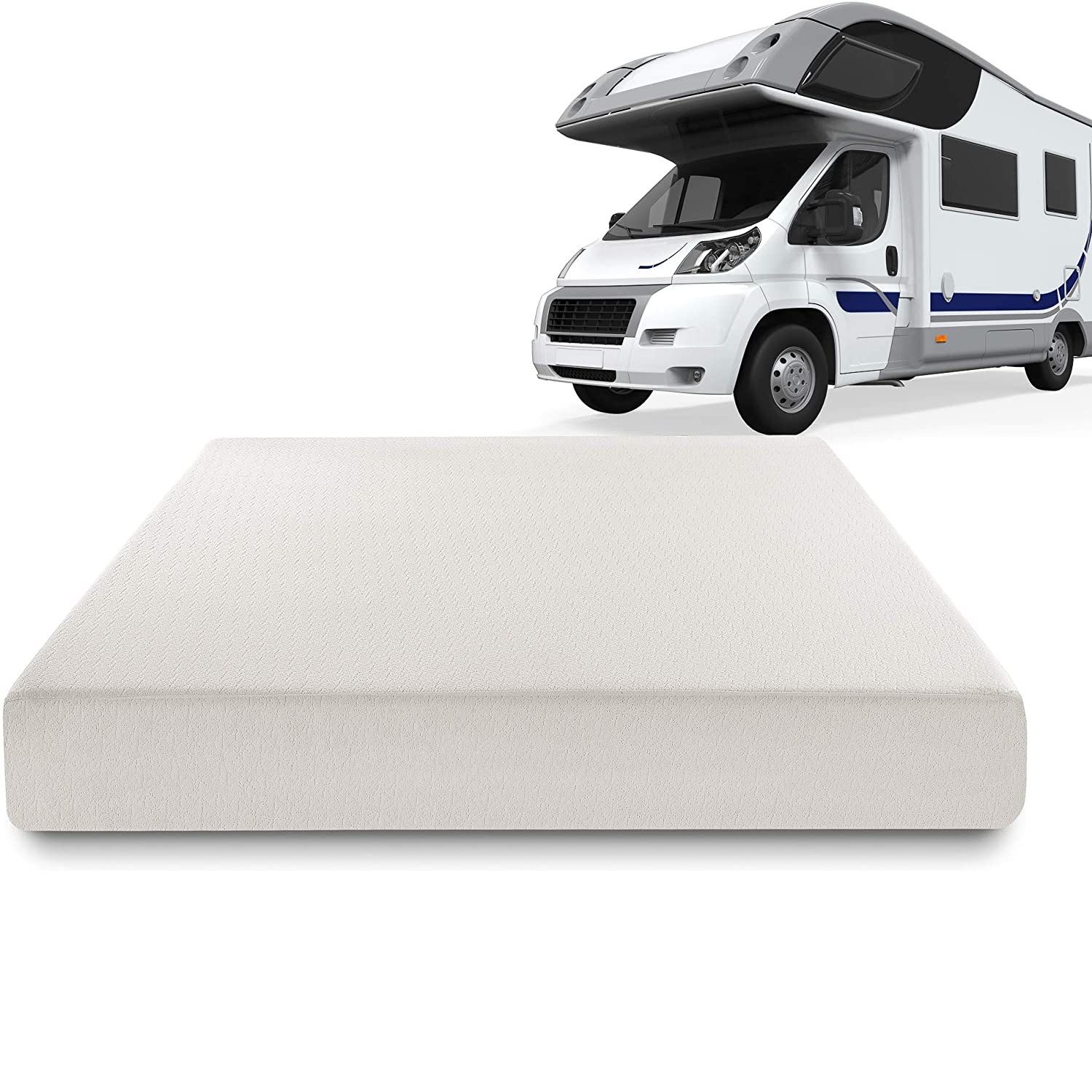
- Size 8 inch
- Brand Zinus
- Item Thickness 8 Inches
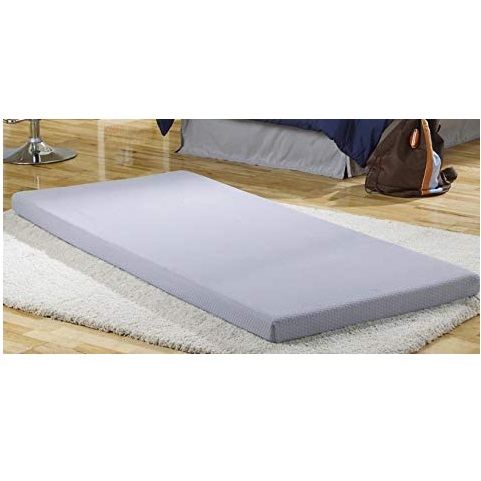
- Brand Beautyrest
- Memory Foam
- Item Weight 8 Pounds
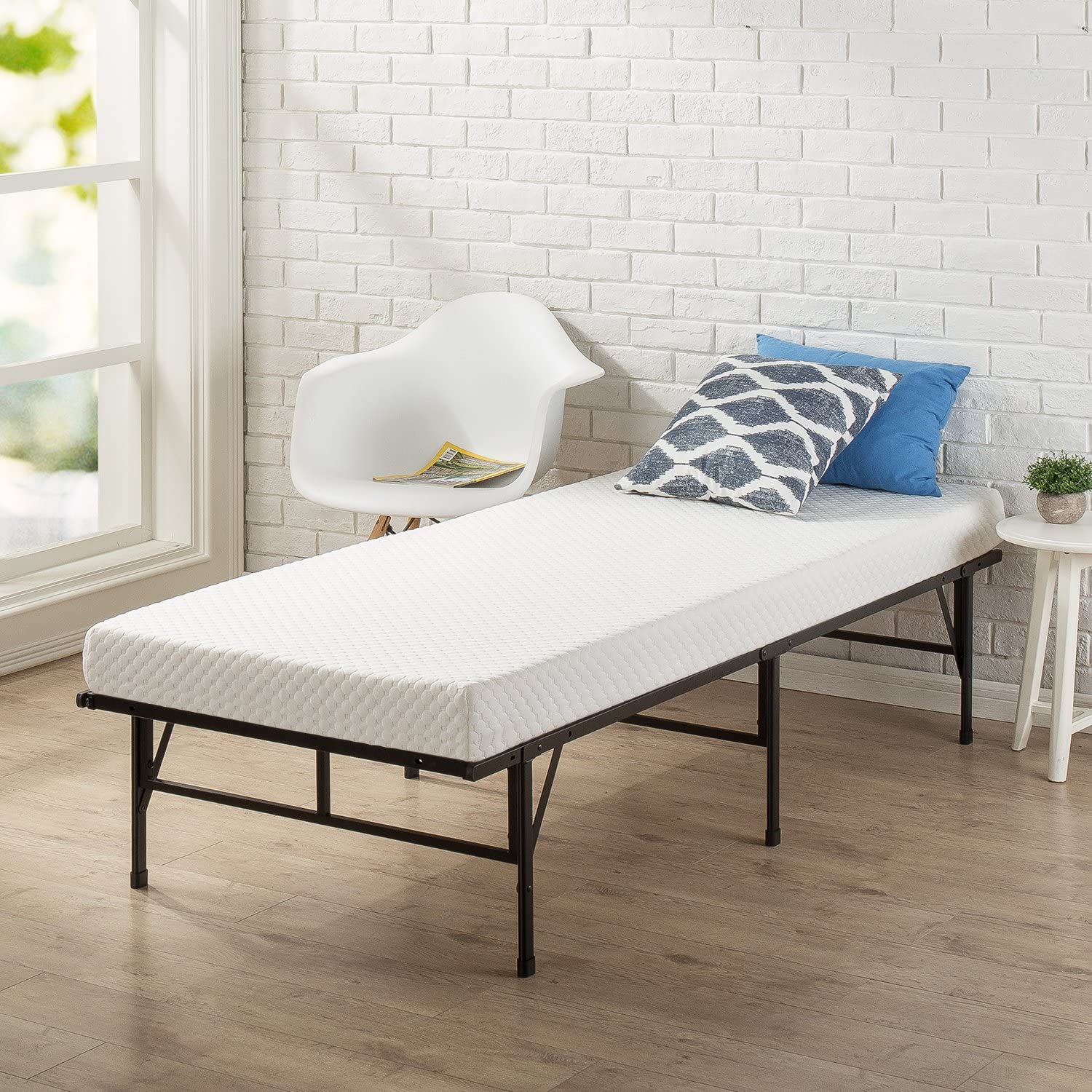
- Size Narrow Twin
- Brand Zinus
- Item Thickness 4 Inches
Choose the Best RV Mattress
Customer’s Choice: the Best Rated Best RV Mattresses
1 users answered this survey. Please help us improve this review!
Do you want to buy a new RV mattress? If so, we have the ultimate guide for you! We will discuss what size and type of mattress are best suited for your needs. We also provide reviews of some popular mattresses on the market today. We hope this article helps you find an RV mattress that suits both your lifestyle and budget!
Table of Contents
Zinus 8 Inch Foam and Spring RV Mattress
 The Zinus 8 Inch Foam and Spring Mattress is all you need to rest your head on at night. Soft, yet durable foam layers combine with steel innerspring-ensuring that this mattress offers a supportive spring for those who prefer softer mattresses or enjoy stomach sleepers.
The Zinus 8 Inch Foam and Spring Mattress is all you need to rest your head on at night. Soft, yet durable foam layers combine with steel innerspring-ensuring that this mattress offers a supportive spring for those who prefer softer mattresses or enjoy stomach sleepers.
This mattress boils down to the perfect match between soft memory foam and firmness, making it a comfortable choice for petite frames as well as heavier individuals alike. Find deep slumber every night with the right balance of feel and support from this mattress!
TUFT & NEEDLE – Original Queen Adaptive Foam Mattress with Antimicrobial Protection
 Feeling like your mattress is lacking some comfort and stability? The T&N Adaptive Foam Mattress with cooling graphite and gel beads will help alleviate that.
Feeling like your mattress is lacking some comfort and stability? The T&N Adaptive Foam Mattress with cooling graphite and gel beads will help alleviate that.
This foam is more advanced and comfortable than outdated materials such as latex and memory foam, providing a flexible sleep surface that adjusts to you, while also pulling away heat with its cooling properties. It has a plush cover designed to keep you cool at night, so lay down on it today–you’ll soon see why this could be your new best friend in bed!
Zinus Deluxe Memory Foam 8 Inch RV
 The Zinus Deluxe Memory Foam 8 Inch RV Mattress is the latest evolution of memory foam technology, with BioFoam replacing some petroleum.
The Zinus Deluxe Memory Foam 8 Inch RV Mattress is the latest evolution of memory foam technology, with BioFoam replacing some petroleum.
Combined with 2 inches of memory foam and another 2 inches of pressure-relieving comfort foam, this combination provides you with everything you need for a refreshing night’s sleep that supports your body all night long. The high-density base support foam ensures years of relaxing slumber. And thanks to the latest in innovative processing techniques used to create our mattress, its conformability will keep adapting to offer relief from back pain or chronic aches so you can wake up refreshed every morning!
Simmons Siesta Gel Foam Lounger
 Boost up the comfort of your living space with the Siesta Gel Foam Lounging Chair. Whether watching TV or just lounging, this versatile foam chair can give you a perfectly comfortable lounging experience anywhere.
Boost up the comfort of your living space with the Siesta Gel Foam Lounging Chair. Whether watching TV or just lounging, this versatile foam chair can give you a perfectly comfortable lounging experience anywhere.
To make storage easy and convenient, it rolls up to only 12″ in diameter for hassle-free transport! This portable size also makes it perfect for dorm rooms, playrooms and as a mattress topper too. Made from lightweight polyethene foam that is resistant to water and other liquids like coffee or wine (though we don’t recommend trying them out!), this comfy-yet-lightweight lounger fits neatly into tight places like under your desk; however, please allow 72 hours for full expansion before use.
ZINUS 4 Inch Foam Mattress
 With the ZINUS 4 Inch Foam Mattress, you can provide your guests with the comfort of home. Highest quality CertiPUR US foam forms this mattress that is durable, easy to ship and manoeuvred.
With the ZINUS 4 Inch Foam Mattress, you can provide your guests with the comfort of home. Highest quality CertiPUR US foam forms this mattress that is durable, easy to ship and manoeuvred.
Zinus is highly breathable. And it’s so easy to install! Just unbox the 4-inch Foam Mattress by yourself, unfold it starting near the centre of the bed frame. The mattress will self-expand to its original size within 72 hours thanks to Zinus premium technology, ensuring that you never have an unmade bed again because of unpacking frustration.
Buyer’s Guide
Benefits of an RV Mattress
- Longer life span compared to other types of mattresses.
- Can be used in all seasons, intended for different climates and weather conditions (depending on the type).
- Lower maintenance than other types of mattresses.
- Ideal for outdoor activities.
- Easily transportable, easily removable.
- Can be used for different sleeping positions.
- Can be used for different sleeping needs, such as camping or travelling.
- Can be easily and quickly installed.
- Cost-effective (depending on the type, brand and current condition of your old mattress).
- Can be used for other purposes (depending on the type).
- They are available in different sizes, styles and brands.
- Can be easily removed when not needed.
- Wide range of accessories to choose from.
What Types of RV Mattresses Are Available?
As you can imagine, there are different types of RV mattresses. The most common include:
- Foam
- Hybrid
- Innerspring
- Latex
- Airbed
Foam mattress: These kinds of mattresses offer the best support and comfort for your back, but they might be a bit stiffer than other options available on the market. They’re also very lightweight and easy to clean. However, some people complain that foam doesn’t breathe well so it tends to get hot during summer days. Also, if not maintained properly (or overtime), these kinds of mattresses can lose their shape or become lumpy in certain areas due to wear-and-tear issues. While this isn’t an issue with all models out there, it depends on the brand and the quality.
Hybrid mattress: These kinds of mattresses are a combination between foam and innerspring, so they’re not too firm (like foam) but also not super soft like latex or airbeds (which is good for certain people with back problems). They provide great support, especially if you tend to sleep on your side most of the time; however, some customers complain that these types of beds might get hot during the summer months since they don’t breathe very well. Also, over time this type tends to lose its shape due to wear-and-tear issues just like memory foam does.
Innerspring mattress: I believe everyone knows what an innerspring mattress is by now, but let’s discuss it just in case. These kinds of mattresses were the preferred choice for people before foam and latex became popular, so they tend to be a bit firmer than other types out there (which can make them uncomfortable if you like softer mattresses or suffer from back pain). They’re also very easy to maintain and clean since all you have to do is vacuum them every once in a while; however, some customers complain that these things get hot during the summer months due to airflow issues. Also, over time this kind tends to lose its shape as well (just like memory foam), which might lead to sagging problems after extended use.
Latex mattress: Latex mattresses manufactured today are completely different compared to the models that were available twenty or thirty years ago. Today’s latex is much more supportive and comfortable, so it provides great support for your back even if you sleep on your side all night long (which can be a problem since innerspring mattresses are really firm). They also breathe well which makes them cooler during the summer months; however, some people complain about springiness issues especially when sleeping with two or three different body types at once. Also, many customers claim that these kinds of beds lose their shape over time due to wear-and-tear problems just like foam ones do.
Airbed Mattress: Airbeds are very popular among RV owners mainly because they provide good comfort levels while being super lightweight and easy to transport. These mattresses are usually self-inflating, which means that they’re inflated with an internal pump and can be deflated as well for easy storage purposes; however, the problem with airbeds is that these things tend to lose their shape after extended use due to wear-and-tear issues (just like innerspring models do), but this depends on different factors like age or how often it gets used. Also, some people complain about noise levels when moving around while sleeping since the material tends to squeak against each other; also, airbeds don’t provide great support so if you suffer from back pain you might want something firmer instead of super soft like latex ones.
So, what types of mattresses are the best for RVs? That’s a great question and I believe that it all depends on your specific preferences, needs and budget. For example, if you tend to sleep hot while camping then an innerspring mattress might be a better option since they provide more airflow compared to foam or latex ones; however, if this isn’t something that bothers you then maybe going with memory foam would make sense instead (since some models out there do breathe pretty well). In any case though, when buying one of these things always check the dimensions first so you don’t end up making a mistake by getting too small or big size than needed!
One more thing: If you have back pain issues then you might want to check out memory foam options since many customers claim that they provide good support even if you sleep on your side.
What to Consider When Shopping for an RV Mattress
If you are still in the market for a new mattress, here is what to consider when shopping for your next one. Keep these important factors in mind so that you can find the perfect fit!
Size
One of the first things to consider when buying an RV mattress is size. After all, you want the bed in your camper or motorhome to fit perfectly and look good while doing it. While many RVs come with a standard queen-size bed included as part of the original design, other beds may need some alterations before they will be suitable for their new owners.
If you plan on travelling quite often and only staying at campgrounds instead of dedicated camping spots, then consider opting for a smaller twin-sized mattress that can easily be stored away during travel times. On the flip side, those who typically stay put or prefer sleeping outside should opt for larger mattresses such as doubles or queens which offer more room than twins do.
While twin sized mattresses may be better for people who only ever plan on using their RV as a place to sleep, they can also be more uncomfortable than bigger beds. More space means more room for you to stretch out and find the perfect sleeping position without touching one side of your bed or encroaching upon another person’s personal space when sharing with someone else.
- The standard mattress size of an RV is 60 x 80 inches.
- If you’re looking for a replacement, the measurements will be similar to that. A good way to measure if your new purchase fits is by measuring the space it needs to fit into and then comparing it with the dimensions on product specs or descriptions – just make sure they match up!
- Most people prefer double beds because they offer more room than twin sized mattresses do when sleeping in RVs that typically stay put at locations instead of travelling around a lot. If security is something that matters most in an RV mattress then consider opting for either queens or doubles which are sure to keep you protected throughout the night.
So choose your size wisely and get ready to enjoy a good night’s sleep in your RV every single time!
Firmness
The next factor to consider when choosing a mattress is the firmness level. If you are an avid camper, it’s likely that you have slept on your fair share of mattresses and know what type of feel works best for you.
If this isn’t the case or if soft beds turn your back into a pretzel then here are some quick guidelines:
- Soft mattresses are best for people who like to sleep on their side. If you generally sleep in this position, the softness will give you the best chance of not waking up with a backache.
- Medium firmness mattresses are ideal for people who sleep in multiple positions including on their side or stomach. If you have trouble getting comfortable at night, then medium level support is best suited to your needs.
- Firm beds are great if you’re looking for something that will keep your spine straight while sleeping in any position but don’t want to feel like you’re hugging the ground when trying to relax after a long day’s hike/climb/kayak trip etc. The downside? You may find yourself tossing and turning throughout the night as it’s tough to get fully relaxed without sinking into too soft of an area which can be prevented by a firmer bed.
If you plan on sleeping in the same position every night, let’s say on your back, then it doesn’t really matter what type of mattress you have as long as it’s comfortable for whatever reason. In this case, the firm is better because there won’t be any pressure points from an excessively soft or hard surface and thus no chance of waking up with aches and pains that could affect your mood throughout the day.
Comfort
You should also consider the level of comfort, support and firmness that you need in an RV mattress. Some mattresses are much firmer than others so if your guests have a preference then it is best to buy one which matches their needs.
For example, the least expensive option for travelers looking for maximum comfort is a memory foam or gel-infused memory foam as these types offer excellent pressure relief but may be too soft for some users. On the flip side of this, those who dislike sinking into their beds will want to look at something like latex rubber instead. This offers great bounce back and staying power through years of use; however, people with arthritis or back problems should take care because they can cause pain when sleeping on them (this goes for all bed types).
For those who want a balance between firmness and comfort, an innerspring mattress will be a great option. These are also popular because the coils can provide additional support for sleepers with back pain or other conditions. The downside to these is they tend to wear out faster than memory foam mattresses so you may have to replace them more often over time.
In addition, if your guests need something that’s easy on the joints then it’s best for them to look into hypoallergenic or anti-microbial options as well as natural latex rubber rather than synthetic materials which don’t breathe very well and retain heat from sleeping bodies easily. This could lead to being uncomfortable even when not coming down with a cold or flu.
While it may be tempting to buy one of the less expensive RV mattress options, remember that if you are hosting guests frequently then they will want something comfortable and durable which is why investing in your own quality bed for them to sleep on is recommended. If money is tight, look into buying an egg crate foam pad instead as these can provide some added cushioning without breaking the bank. This works especially well if you already have a memory or latex foam mattress (which tend to be rather pricey).
Another great option for those looking for comfort but don’t mind spending more cash would be getting two twin mattresses with decent inner coils; this way everyone gets their own firmness level while still providing even support across both beds – and they can be rotated and flipped regularly to help extend their lifespan.
For extra softness, you may want to consider adding a memory foam mattress pad or gel-infused pillow top over an innerspring mattress; these are easy enough to find at most department stores such as Walmart (for cheap) but won’t add much support. They will also warm up quickly when exposed to the heat from your RV’s furnace/AC system so look for something which is thermally insulated if this is a concern of yours.
Sleeping Position
A sleeping position has to be considered because it can affect the support level that you will receive. If you are a back sleeper, then memory foam is not for you because it has great contouring properties which mean there wouldn’t be any space between your body and the bed surface.
On the other hand, if you sleep on your side or stomach, this type of mattress might not give enough pressure relief to let you have restful nights. Memory foam mattresses are often denser than traditional types so they could feel too firm when sleeping in these positions. People who tend to sleep off their backs usually need beds with more conformance since they sink into them more easily while those who prefer sleeping face down need firmer surfaces that keep their hips lifted and prevent sinking as well as pressure relief.
Moreover, if the mattress is too soft, it will not support your body correctly so you can develop sleep problems. If on top of that, the sleeping surface has dips or valleys where your back rests while sleeping in these positions, then even more pressure points are created and this could be very uncomfortable for someone who prefers to sleep off their stomachs.
If you sleep with someone else, you need to take into consideration that the mattress has enough space for each person. When two people sleep together, they often move differently and this could interfere with their partner’s movements causing them not to get a restful night or even waking up in pain because of it.
No matter what position do you usually adopt when going off to dreamland, make sure your RV mattress is versatile so it can be used in different sleeping positions comfortably.
Bodyweight
One more important factor to consider is the person’s weight. You should consider your weight and the combined weight of you and a partner because that is what will be pressing down on the mattress at any given time. A twin size bed can hold about 500 pounds while a king-sized bed can only handle around 450 pounds.
Depending on the weight of your partner, you might want to consider a queen-sized mattress that can hold around 650 pounds.
Another thing to remember is that if two people are sharing an RV bed and one person has more than 25% body fat, it could actually cause permanent damage to the mattress due no matter what type of material it’s made out of. The reason for this is simple: humans sweat when they sleep (and most likely drool too) which will break down any foam over time, regardless of how high quality or expensive it may be.
If you’re overweight then there are some mattresses that would work better for you since their design makes them suited toward heavyweights; however, they also cost so depending on your budget keeping the weight down may be the best option for you.
Weight distribution is important because if one person sleeps in a specific position or moves frequently they can create pressure points and cause indents that won’t go away no matter how much time passes. This will make your mattress less comfortable to sleep on overtime, so it’s better to start with good quality materials from the beginning rather than try and fix an inferior product later on.
A heavier person will need a more durable mattress with extra support, whereas lighter people may be fine with something less heavy-duty. It’s all based on your weight and the size of the bed that you need; this is why it’s important to consider both these things.
The best way to determine the weight of a mattress is by reading Amazon reviews. Look for comments that mention specifics like “heavy” or “light.” This will give you an idea of how thick, dense and durable it is.
Thickness
Thickness is the primary factor while choosing an RV mattress.
An ideal thickness of a best RV mattress is around six inches to eight inches. This will provide enough comfort and support for your back, neck, and shoulders during sleep time.
In case if you are opting for a thicker one then it should be no more than ten inches thick because this may affect the headroom inside your bed area or storage space in some models which can add extra weight that makes driving difficult. In such cases, it is advisable to go with lightweight foam mattresses instead of heavy-duty ones. Besides, thinner pads could develop pressure points that cause discomfort when lying on them for an overextended amount of time periods resulting in pain in certain areas like hips etc. On other hand, heavier mattresses are costlier and difficult to transport from one place to another.
The thickness of a pad or mattress is important because it not only determines the comfort level but also affects your overall driving experience. It’s essential that you check each product specification before making a purchase decision.
In case if you are choosing an airbed then make sure it is at least fifteen-inch thick with multiple chambers as this will be easier for inflation purposes, faster-pumping speed, longer-lasting durability etc. compared to single-chamber products available in the market. In addition, they tend to have more firmness options which can provide better support than standard foam mattresses do. The drawbacks associated with these types of beds include noisy operation during sleep time due to high-pressure levels inside inflatable chambers resulting in a whistling noise.
Support and Pressure Relief
Another thing to consider when buying an RV mattress is support and pressure relief. This will depend on your height, weight, sleeping style, bed size, etc., but here are some general things to keep in mind:
- Support – You want a supportive mattress that doesn’t sag over time. Dense foam mattresses tend to be the most supportive because they limit airflow through their design. Airflow can lead to sagging over time causing you not to get back pain after long road trips or overnight stops at campgrounds for days on end due to lack of sleep.
- Pressure Relief – A good place for finding dense foam is memory foam which contours around your body while minimizing sagging with airflow limitations built into its construction materials (i.e. graphite). Memory foam can be great for pressure relief if you’re on the taller side.
- Density – You want to find a mattress that has enough density so it doesn’t sag but also gives your body some “squish” when needed (i.e. while driving). The denser the memory foam, typically the more support and less squish you would get.
- It’s important to know that denser foam mattresses are often more expensive than other types of materials like latex or air (coming up next), but they’re extremely durable and can be great for providing support along with pressure relief.
- You may want to consider buying a mattress pad that is less dense, meaning it’ll sink in further when you lay on top of it giving the feeling of sinking into your bed while still offering some degree of supportive qualities so you don’t feel all sunken-in over time. This will also help keep the existing padding underneath making it last longer.
Temperature Regulation
You have to consider temperature regulation. A memory foam mattress is a great choice for many reasons, but it can be very hot in the summer. This will make it hard to stay cool and comfortable. Look for a mattress that has been infused with cooling gel, as this can help keep you from sweating during those hot summer nights.
Viscoelastic memory foam adds to this issue because they are not airy at all and when you sleep on them there will be no airflow whatsoever. They also have high density so even if your RV has an AC system that cools down the whole vehicle with cold air, chances are that your bed won’t feel any breeze.
If you are a hot sleeper, look for an innerspring mattress. These types of mattresses have coils that can make it easier to regulate your body’s temperature with airflow and the assistance of fans.
You should look for mattresses made of gel-infused memory foam or latex rubber, one which is more breathable than other types mentioned before. Latex rubber ones have two major benefits – they provide great support while being still pretty lightweight and their cooling effect makes sure you stay fresh throughout the night without feeling overheated.
Temperature regulation is important because you have to consider that when you sleep in a moving vehicle it might get even hotter than outside.
Another thing to consider is the material on top of your memory foam. If you choose one that isn’t breathable or moisture-wicking then it could end up causing some problems when the temperature climbs too high. You want something that is going to let air flow so there’s better ventilation throughout the night while still keeping all of its supportive qualities intact.
Location
Location is also important because it can either provide or take away from the comfort of your mattress. If you are someone who likes to sleep in an area that is cold, then a cushion that will warm up throughout the night might be ideal for you. Also if you have back problems, it may help alleviate them with additional support on certain areas around your body.
The location where most people prefer their mattresses are usually inside their homes because they do not want to carry out bulky beds every day. Because RV’s lack storage space, this option provides more room for other items while also being mobile enough so that transportation does not become too burdensome. For some that are a huge benefit and for others, the comfort of their mattress may be more important than storage space.
So before you decide to purchase an RV mattress, think about where you will be using it most often and how much weight you are willing to carry on your trip. Then compare the cost with factors including size, the material used in the construction process, warranty offered by the seller, convenience & portability etc. After determining which factors are necessary or not consider all options available then choose one that works best for your family.
If you plan on camping in cold weather, it makes sense to look for one that is insulated. This allows you to stay warm throughout the night without spending extra money on bulky blankets.
Another option would be an air mattress or bed-in-a-bag which are both more convenient options but also less comfortable compared to others especially if they lack support in certain areas of your body. But at least it can provide a better source of comfort when camping with children because sometimes kids tend to move around quite often during their sleep time!
The ultimate goal, however, should always be finding something that provides enough space for yourself and maybe another person while being able to withstand heavy usages such as outside weather conditions and possible spills.
But if the temperature is always warm where you camp, then you can definitely opt for something that is lightweight, easy to set up and pack.
One of the most important things with choosing an RV mattress is to always consider your own needs first then choose a product or brand that will help meet those expectations. Although it may seem like there are limited options due to space constraints but they do exist so take advantage of what they have available!
Off-Gassing
When you begin to read about RV mattresses, one thing you’ll most likely run across is the term “off-gassing”. This refers to a chemical release that can occur when new foam products are brought into an enclosed space. The chemicals released will be inhaled by anyone in close proximity including yourself. It’s important to note that this isn’t dangerous; it’s simply something that should be considered before purchasing your mattress. Most people find that the off-gassing period is over within a few hours to an overnight sleep.
You should also note that this effect will be more prevalent in lower end mattresses, like those made out of polyurethane foam (this kind of product can contain flame retardants). Higher quality memory foam products are usually less prone to off-gassing; however, they do still produce some chemicals during their initial expansion process. For these reasons, it’s best to purchase your RV mattress from a retailer with a liberal return policy if you’re concerned about possible side effects.
Moreover, if you have allergies, it might be a good idea to purchase from a retailer with an open floor model policy. In this case, you can find out how the mattress reacts to off-gassing before purchasing and returning your product is as easy as possible.
For most people, the off-gassing period is not an issue at all. However, if you are sensitive to chemicals or have respiratory problems, it can be a major point of consideration in your mattress purchase decision.
Accessories
There are a lot of other accessories you can buy to customize your RV bed for comfort. The most popular are:
- RV mattress toppers: These come in memory foam and can be helpful if you already have an uncomfortable mattress. They will provide a bit more cushion, but they won’t make up for having the wrong type of mattress. The best way to figure out what kind of topper is right for you is by talking with someone at your local camping store or checking online reviews from other people who bought one that matches your situation.
- Bed skirts: Some people like these and some don’t. If you have a more permanent attachment to the bed frame, it’s not going anywhere and doesn’t really need something underneath it holding up sheets or blankets. But if you want that extra look of luxury with your RV mattress then this is an easy way to get that – as long as your existing cover fits over the top of whatever skirt material you choose!
- Mattress protectors: These are great for keeping spills from getting into the actual mattress itself. They’re also helpful when using a memory foam pad because they’ll help keep them clean so there isn’t any kind of lingering smell after accidents happen (or on purpose). Many people will even use two layers here just in case one gets dirty at some point down the road.
- Mattress pads: This is another option for additional comfort on top of your existing mattress or topper. They’re not as thick but will provide some extra cushioning that you might enjoy if the RV mattress itself isn’t enough. These are also an alternative to bed skirts because they can easily be tucked underneath the covers instead of having something show overtop all the time.
- Bedsheets and pillowcases: You can choose whatever colour styles fit your personality best here! We recommend finding a set where there are at least two different colours so it looks more like part of a matching ensemble than one glaring piece standing alone in contrast with everything else around it (i.e., black/white striped sheets look nice next to white walls but are too matchy-matchy with lighter coloured furniture or decor).
- Bed in a Bag: This is the best option for people who are looking to get everything they need all at once. Instead of having to shop around separately, this set will have everything you could possibly want – sheets included! Some sets even include extra pillows or other comforts that work well with an RV mattress because it’s difficult sometimes to know what kind of pillow might be most comfortable when there isn’t much space underneath your head while you sleep (you can flip and flop easily).
Warranty
Last but not the least, it is advisable to check out the warranty of the product. It will play a pivotal role in keeping your mattress safe and sound even if you make use of it more often or not. The warranty period can be anything between one year to ten years, depending on the brand and the type of mattress you buy.
If your product comes with a limited warranty, it is advisable that you keep all documents related to service in an organized manner so that if the need arises; they will not cause any inconvenience or issue in future for sure! This will play a pivotal role when you want to claim its warranty in near future without causing much trouble.
Good brands usually offer a warranty on their products for around two to three years. Manufacturers like Lucid, which make good quality RV mattresses, usually offer a limited warranty period of five years or more because they are confident about the durability and strength of their product!
Note: If you want to ensure your safety along with that of your vehicle’s interior; it is advisable that you buy an expensive yet durable model at least.
Care and Maintenance
- To keep your mattress smelling fresh and clean, you should vacuum the surface with a soft brush attachment.
- In case of spills or stains, never rub them as they will damage the fabric. Use only mild detergents to spot treat spots on your RV mattress cover.
- You can also skip cleaning by using RV protective covers that are waterproof for protection from any kind of spillage. These protectors effectively shield against dust mites and allergens too which is why they’re a great choice if someone in your family has allergies or breathing issues
- Never apply heat to remove dirt stuck inside seams because this may cause shrinkage and make the seam pop out leaving behind an unsightly lumpy area on top of your mattress.
- If you are looking to remove stains, use a professional service that specializes in cleaning RV cushions and mattress covers because they have special equipment for this purpose. You can also check out the internet or ask your friends if they know of anyone who may be able to help with taking care of these issues
- Avoid putting heavy objects on top of an unzipped cover as it could cause damage by stretching the seams apart. If there is no alternative but to put something heavy over the bed then do so only after zipping up the cover completely
- To prevent mildew from forming under your sheets, make sure you dry them completely before storing them away especially during winter months when humidity levels tend to go down quite considerably indoors.
- You should also check for tears in your mattress cover and make sure to patch them up immediately before they become a problem.
FAQ
What is the top-rated RV mattress?
With so many different brands and styles on the market today, it can be difficult to find the very best RV mattress.
Fortunately for you, we have done all of the research for you! Our list above will give a quick snapshot as well as the pros & cons that come with each type of mattress.
How thick should an RV mattress be?
It is important to know that RV mattresses are typically much thinner than traditional mattress styles.
The average thickness of an RV mattress is about three inches, although there are some available as thin as two inches!
Can I put a regular mattress in my RV?
You can, but it won’t be very comfortable.
RV mattresses are designed to fit the contours of your body and distribute weight evenly – something regular mattresses just aren’t equipped for!
Is an RV mattress the same as a regular mattress?
Nope!
Regular mattresses are made for the average height of an adult, whereas RV mattress heights vary based on many different factors.
How long will my new RV mattress last?
Again, that depends entirely upon your personal preference and usage habits. If you are planning to use it every day then most likely you can expect at least a few years. If you will use it occasionally or on vacation, expect to get about half that time out of it!
What is the difference between a regular queen bed and an RV queen bed?
The standard queen bed in a home is usually 60 inches wide by 80 inches long, with an average height of about 15-16 inches.
RV mattresses are smaller and thinner than the traditional mattress styles found in homes – typically measuring around 42 x 75″. They also have different thicknesses based on weight capacity needs!
Are RV mattresses comfortable?
The short answer is yes. Many RV mattresses are designed to be just as comfortable as a regular mattress, so you won’t have to worry about sacrificing comfort while camping. However, the best RV mattresses come with some special features that make them even better than traditional beds. For instance, many of these mattresses feature specialized foam layers that provide optimal support and pressure relief for your body. They also use materials like memory foam, latex or hybrid foams which contour to your body shape and help reduce tossing and turning at night. With all these features combined, you can expect a great night’s sleep on an RV mattress!
Do RVs need special mattresses?
The answer is yes! Regular mattresses won’t work in RVs because they don’t fit the shape and size of RV beds. An RV mattress is specially designed to fit snugly into the limited space of an RV bed frame, ensuring a good night’s rest.
RV mattresses come in a variety of sizes, ranging from Twin to Queen, and thicknesses vary as well. To ensure you get the best fit for your RV bed, it’s important to measure accurately before making any purchase decisions.
How do you decide which mattress is best for your RV?
The most important factor to consider when purchasing a mattress for your RV is finding one that fits into the space you have available. Measure your space, including any convertible furniture or stored items, and make sure the mattress you select will fit. Additionally, think about how many people will be sleeping in the bed at once – do you need a queen-sized bed or two twin mattresses? You may also want to consider an air mattress with adjustable firmness levels for versatile comfort.
Are there any special considerations that need to be made when choosing a mattress for an RV?
When choosing a mattress for your RV, there are a few key things to consider. Firstly, the size and shape of the mattress must fit your RV precisely; otherwise it may not provide the same amount of comfort or support as an appropriately-sized bed. Secondly, you should also pay attention to materials used in the construction of the mattress; many RV mattresses are made with coils or foam that provide greater support than traditional beds. Finally, you’ll want to be sure that any mattress you purchase is designed specifically for RVs – this will ensure that it lasts longer and provides better comfort when traveling from place to place.
What is the best way to store a mattress when you’re not using your RV?
The best way to store your RV mattress is to keep it in a climate-controlled environment and out of direct sunlight. This will ensure that the material, whether foam or springs, doesn’t become warped or damaged over time. Additionally, you can use a mattress cover to protect against dirt and moisture buildup that could cause mold or mildew growth. If possible, you may also want to periodically rotate the mattress so all sides receive equal wear-and-tear. However, if this isn’t feasible due to space constraints in your RV, simply make sure the mattress is properly secured so it won’t shift around with movement.
Does an RV mattress need a box spring?
No, an RV mattress does not need a box spring. Many RV mattresses are designed to be used without a box spring due to their unique shape and size. However, this doesn’t mean you can’t use one if you prefer the look or feel of a more traditional bed setup. There are also various mattress foundations designed specifically for RV mattresses that provide added support with minimal space taken up in your camper or motorhome. Additionally, many people opt to use slats beneath their mattress instead of a box spring for extra stability and durability.
Can you put a TempurPedic mattress in an RV?
Yes, you can put a TempurPedic mattress in your RV. However, the process is slightly more complicated than just setting up a regular mattress. It is important to measure the dimensions of your RV’s bed carefully and make sure that the TempurPedic mattress will fit properly. Additionally, some modifications may be necessary to ensure that the mattress fits securely within the frame of your RV bed. If you’re unsure about how to set up a TempurPedic mattress in an RV, it’s best to consult with a professional who has experience doing this type of work. They can help make sure everything is done correctly and safely for optimal comfort and support while you’re out on the road.
Does Sealy make RV mattresses?
Yes, Sealy does make RV mattresses! They have a range of options designed to fit RVs and other recreational vehicles. Whether you need something for just a few nights or long-term camping trips, Sealy has the perfect mattress for you. Their mattresses are made with high-quality foams that provide superior comfort and support, as well as temperature regulation for a more restful sleep. Choose from firm, plush, or memory foam models that can be easily installed in your RV so you can enjoy a good night’s sleep wherever your travels may take you.
Does Beautyrest make an RV mattress?
Yes, Beautyrest does make mattresses specifically designed for RVs. Their selection includes 8” high-profile RV mattresses with an individually wrapped coil system and a plush top that provide both comfort and support. These mattresses are available in twin, full, queen and king sizes. Additionally, they offer an extra-long 80” mattress perfect for those needing a little more space while traveling. All of their RV mattresses come with a 10 year warranty so you know you’re getting quality craftsmanship built to last.
Does Sleep Number make an RV mattress?
Sleep Number does not make an RV mattress, but they offer a variety of other sleep solutions that are perfect for RVs. Sleep Number mattresses are specifically designed to fit standard bed frames and may require some adaptation to work with the unique size and shape of an RV space. If you’re looking for a way to upgrade your sleeping experience while on the road, there are plenty of other quality mattresses out there designed specifically for RVs. From memory foam designs that contour to your body, to pocket coil support systems that provide a firm base layer, there’s something for everyone when it comes to finding the best RV mattress.
Useful Video: Top 5 Best RV Mattress Review
Final Thoughts
The best type of mattress to buy is the RV foam one when you are on a budget and if your individual needs include camping or travelling often with no fixed place to sleep. If you have more money, go for an inflatable double high air bed which provides maximum comfort due to its dual-layer design (the top side is plush while the bottom part has firmer support). For those who need something softer still, choose either an adjustable height/size model or an inflatable single high flexible bed. All these types of beds come in different sizes so make sure you get exactly what suits your situation before buying!
We hope our Ultimate Guide to Buying an RV Mattress was useful and will help you make the best choice when buying your next mattress!
Tell us about your experience or what type of mattress you plan on getting in the comments section below!



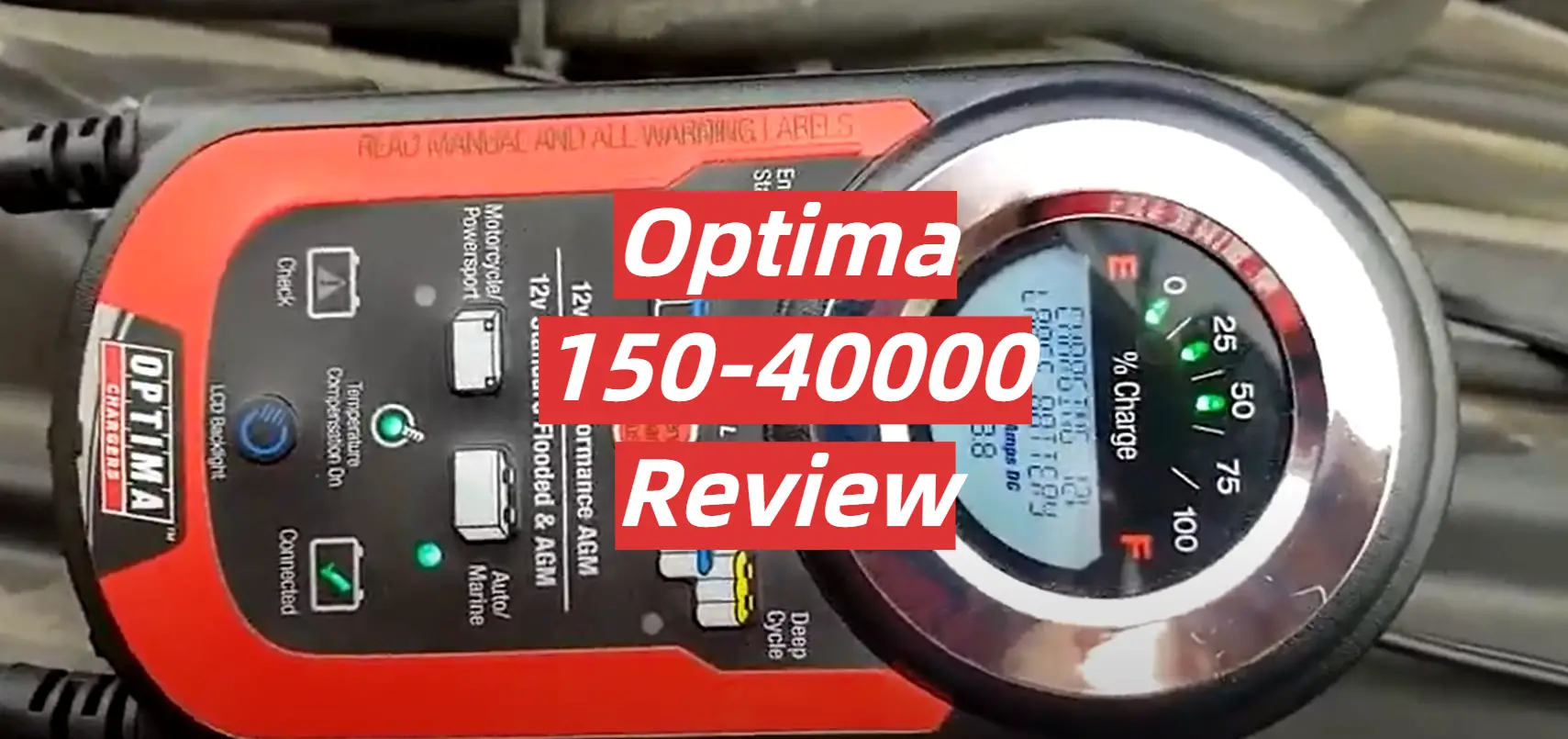
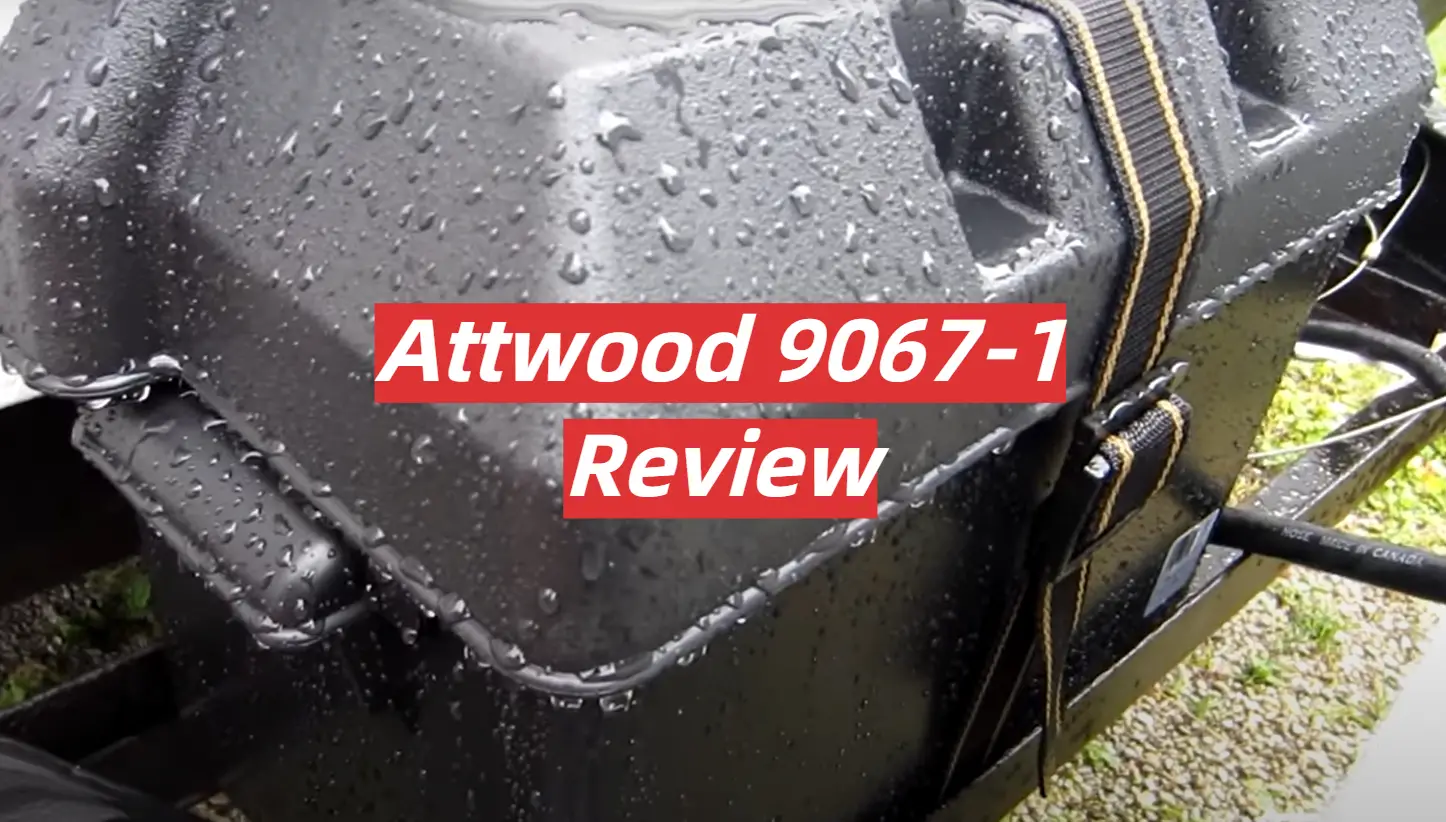

Leave a Reply